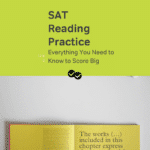On every SAT, there’s one fiction passage from “U.S. or World Literature” (yeah, that does basically mean anything in the world, as long as it’s written in English). The literature passage is the first passage in the Reading section.
The redesigned SAT likes relatively recent fiction, but it’s not unheard of to see something older–works anywhere from the nineteenth to twenty-first century are pretty fair game. There’s a wide range of time periods and writing traditions that the story might come from. There are two things you can be sure the Reading passage won’t be, though: written in totally antiquated English (such as Dante’s Inferno) or taken from a young adult series (such as Twilight. Sorry, Bella).
Sometimes the literature passage will be the easiest reading in the entire section, and sometimes it will be the hardest. You’ll usually know within the first paragraph. Sometimes you’ll think the story is engaging, which is such a nice bonus. But don’t get too caught up in the tale. This the SAT, after all. Questions are coming, and we need to be ready to answer them.
Here are some tips on approaching the New SAT Literature Passage:
Read the intro information
Before every Reading passage on the SAT, there are a couple of sentences that tell you where the text is taken from and give you a little bit of background info if necessary. You should always read this, especially when it’s a fiction passage. For one, it tells you it’s fiction and that affects what your note-taking strategy will be (more on that in a moment). Besides that, it may give you some important background info on the setting and characters to help orient you. The copyright date is also an important clue regarding the era a passage was written in, which can tell you a lot about the author and his or her world.
Gradually describe characters
As you read, keep track of the characters you meet. There will only be a few—maybe two or three—so this shouldn’t be too tough. But as you read, build up a list of descriptions of those characters. Focus on their personalities and motivations especially; how does the author paint them? Any adjectives you see to describe their personas are worth underlining or circling. It’s good to be thinking about the author’s intentions when you’re doing this. Is the attitude toward a character positive, negative, or neutral
Describe the relationships between the characters
You want to build up not just an image of each personality but a description of the relationships between them. Take careful note of how characters feel about each other or react to each other. The SAT will almost always ask you about this.
Write these character traits in your notes
Jot down notes about the characters alongside the passage as you read. They don’t need to be extensive. “Mary = mean-spirited; Susan = naive” will suffice. This will be a really helpful guide for when you answer questions about characters.
Note the turning point(s)
Pretty much every literature passage on the SAT is going to have some type of “turning point” where something happens to a character, a character remembers something happening to them, or a character has a revelation. This turning point is often crucial to understanding the point of the story. Put a big star by it when you find it. As a bonus, looking for the turning point helps keep you actively engaged in your reading.
For more new SAT info, check out Magoosh’s free SAT study guide!






Leave a Reply